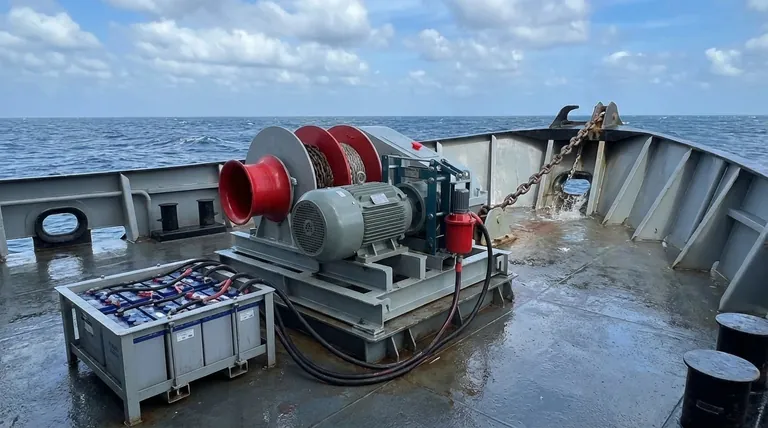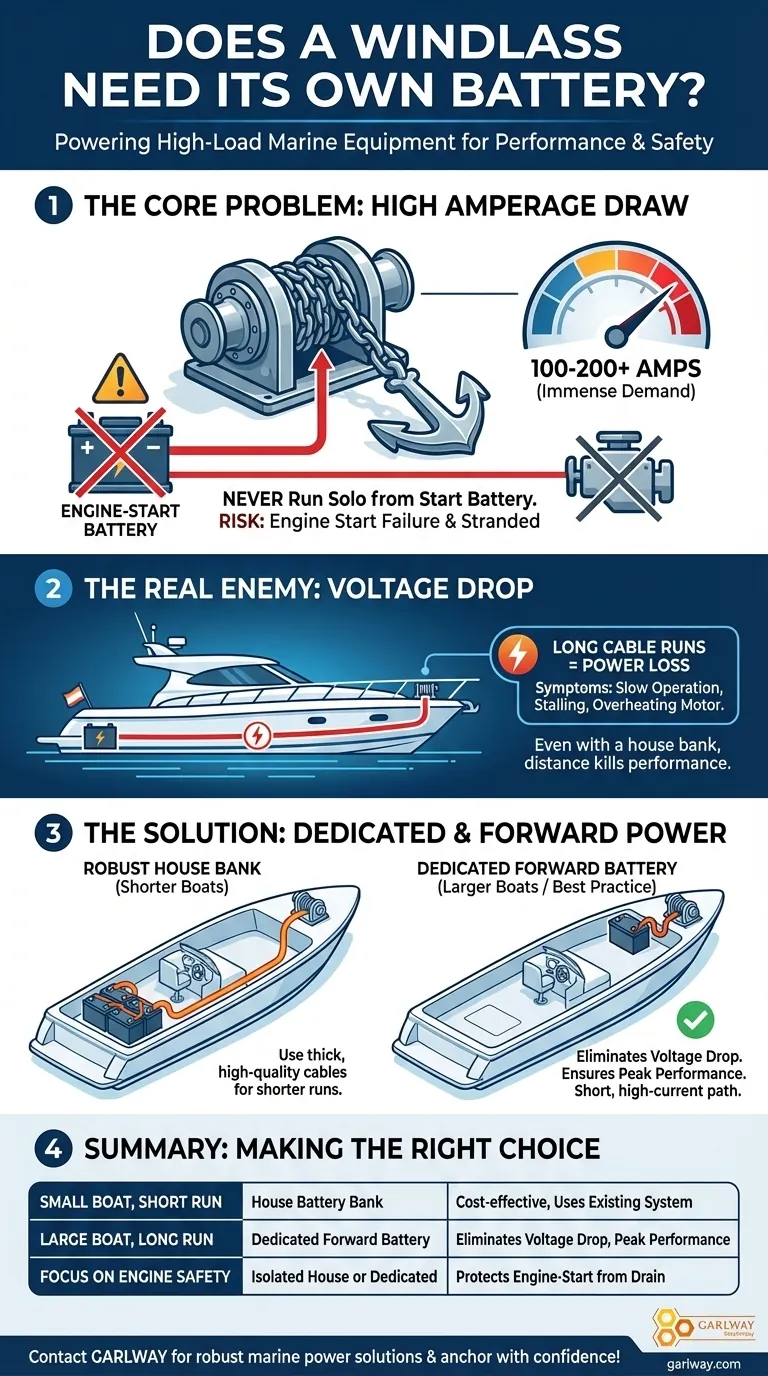No, a windlass does not strictly require its own battery, but it absolutely must not be run from the engine-start battery alone. The immense power draw of a windlass makes it standard practice to power it from a separate, dedicated "house" battery bank or a forward-mounted battery to ensure reliability and protect your boat's critical systems.
The core issue is not just about having a separate battery, but about managing the massive, short-term power demand of the windlass. This demand can drain your starting battery or suffer from severe performance loss (voltage drop) over long cable runs, making a dedicated or nearby power source the superior engineering solution.

The Core Problem: High Amperage Draw
A marine windlass is one of the most power-hungry pieces of equipment on a vessel. Understanding its impact is key to designing a reliable electrical system.
Why It Draws So Much Power
A windlass motor is under extreme load as it lifts hundreds of pounds of anchor and chain from the seabed. This work requires a massive amount of electrical current, often drawing 100 to 200 amps or more during operation.
This is a significant and sudden demand on your electrical system, far exceeding that of lights, pumps, or navigation electronics.
Protecting the Engine-Start Battery
The single most important rule in marine electrical design is to protect the engine's ability to start.
Connecting a high-draw device like a windlass directly to your start battery creates a serious risk. Operating the windlass for even a short period could drain the battery enough to prevent you from starting your engine, leaving you stranded.
For this reason, all non-essential, high-load equipment should be powered by a separate "house" battery bank.
The Real Enemy: Voltage Drop
Even when using a large house battery bank, another critical problem arises: voltage drop. This is often the primary technical reason for installing a dedicated battery near the windlass.
How Cable Length Kills Performance
Electricity loses voltage as it travels through a wire, and this loss increases with the length of the wire and the amount of current flowing through it.
A windlass is typically installed in the bow, while battery banks are often located aft or mid-ship for weight distribution. This can result in a very long cable run—often 25 feet or more. The high amperage draw over this long distance causes a significant drop in voltage by the time the power reaches the windlass motor.
Symptoms of Inadequate Voltage
A windlass starved of proper voltage will perform poorly. You will notice it running slowly, struggling under load, or even stalling completely.
This not only makes anchoring difficult but also generates excess heat in the motor, which can drastically shorten its operational life.
The Forward Battery Solution
The most effective way to eliminate significant voltage drop is to shorten the high-current cable run.
By installing a dedicated battery (or small bank) in the bow, close to the windlass, the heavy-gauge cables that carry the 100+ amps are only a few feet long. This ensures the windlass motor receives the maximum voltage and performs as the manufacturer intended. The longer, smaller-gauge charging wire from the alternator or charger is not subject to the same extreme voltage drop.
Understanding the Trade-offs
While a dedicated forward battery is the ideal technical solution, it comes with practical considerations.
Cost and Complexity
Installing a separate battery requires more than just the battery itself. You need a proper battery box, heavy-gauge cables, fuses, and a method to keep it charged, such as a battery-to-battery charger or an automatic charging relay (ACR). This adds cost and complexity to your system.
Weight in the Bow
Adding the weight of one or more batteries (which can be 50-70 lbs each) in the bow can affect your boat's trim and performance. This is a critical consideration, especially for smaller or performance-oriented vessels.
Maintenance
A dedicated battery is another component to monitor and maintain. You must ensure it remains properly charged and in good health, adding to your regular maintenance checklist.
Making the Right Choice for Your Boat
Your decision depends on your vessel's size, your existing electrical system, and your performance requirements.
- If you have a smaller boat (under 30 feet) with a house bank located relatively close to the bow: You can often power the windlass directly from the house bank, but you must use extremely thick, high-quality marine cabling to minimize voltage drop.
- If you have a larger boat or a long, complex cable run to the bow: Installing a dedicated battery forward is the superior engineering choice to guarantee performance and reliability.
- If your primary focus is absolute reliability and safety: Isolate your windlass power from the engine-start battery. Power it from a robust house bank or a dedicated forward battery to ensure you can always start your engine.
Ultimately, ensuring your windlass has access to ample power without jeopardizing your engine is fundamental to safe and stress-free boating.
Summary Table:
| Scenario | Recommended Power Source | Key Benefit |
|---|---|---|
| Small boat, short cable run | House battery bank | Cost-effective, uses existing system |
| Large boat, long cable run | Dedicated forward battery | Eliminates voltage drop, ensures peak performance |
| Focus on engine safety | Isolated house or dedicated battery | Protects engine-start battery from drain |
Ensure your windlass performs reliably and your engine starts every time. GARLWAY specializes in robust construction machinery, including winches and power systems ideal for marine applications. Our expertise helps construction companies and contractors globally design durable, high-performance solutions. Contact GARLWAY today to discuss your specific power needs and anchor with confidence!
Visual Guide

Related Products
- Heavy Duty Electric Boat Winch Windlass Anchor
- Warn Winch Windlass Boat Trailer Winch
- Electric Hoist Winch Boat Anchor Windlass for Marine Applications
- Ready Mixer Machine for Construction Ready Mix Machinery
- Portable Cement Mixer with Lift Concrete Machine
People Also Ask
- How does the anchor windlass operation sequence work? Master Safe & Controlled Anchor Handling
- How much current does an electric boat winch draw? Plan Your Electrical System for Peak Performance
- What is the difference between anchor windlass and mooring winch? Essential Guide for Marine Equipment
- What are marine electric winches and their characteristics? Key Features for Reliable Maritime Operations
- What is the general user satisfaction with boat anchor winches? A Game-Changer for Boaters


















